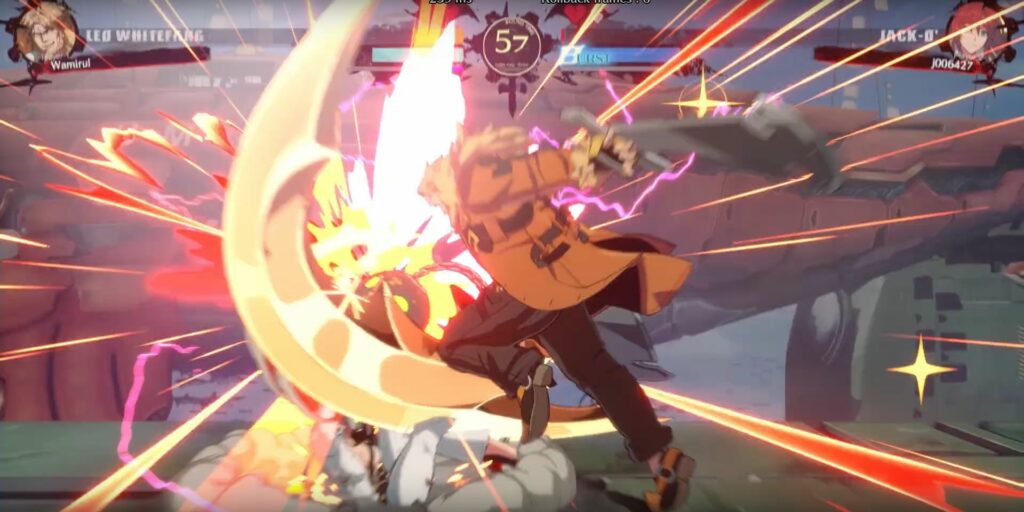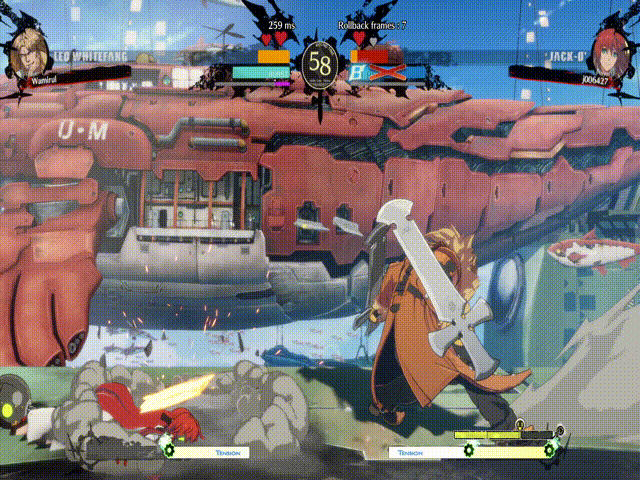If you’ve ever seen the announcement cycle for a fighting game, one of the biggest questions is always “will it have rollback?”. It used to be a rare feature- but nowadays, it seems like more fighting game developers have embraced the netcode that’s making international matches play like a dream.
This feature was originally published on the GamerBraves Newsletter. Subscribe for free to get access to more articles like this before they become publicly available.
So what is rollback netcode? When you think about it, a fighting game is just two computers feeding information to each other with rules on how to resolve said information. Did Computer A punch? did Computer B block said punch? When you’re playing next to each other, it’s pretty straightforward with how that resolves. But when you’re playing online, latency means that information isn’t always going to get there on time.
Most Japanese fighting games as a result used what’s known as Delay-Based Netcode. Think of it like this: if you knew that a match had a 6 frame delay (0.1 seconds), why not just have your opponent’s buttons (messages) delayed by 6 frames so its a fair playing ground?
While it works on paper, it falls apart really easily. For one, this doesn’t take into account that most internet connections are unstable- you could have a 6 frame delay now, then go back down to 2 before shooting back up to 7.
Some characters had their highest level of play unusable because of bad netcode
Two, there’s the issue of the games just not being fun to play since you’re being artificially delayed. Fighting games are surprisingly high precision- so having your inputs be artificially delayed by arbitrary amounts depending on who you fought is a good recipe for disaster.
Rollback netcode is a solution to this: in the A and B scenario from earlier, computer A will guess what B does, showing you the result. So from the perspective of player A, you might see B blocking, and since they did, the situation plays out as normal.
Every so often, the computer will guess wrong- in which case they will roll back the simulation, instead showing you what really happened.
Case in point- in this match, Leo (right) is going to hit Jack-O (left):

So from the Leo’s perspective, the overhead connects, winning the round and even getting the dramatic zoom in for last hits:

However, the Jack-O player *actually* blocked the hit on their end, and so the game rolls back even the victory to instead show what really happened: that the Jack-O successfully blocked the attack.

Here’s how that looks in action:

This is obviously an extreme case. This was a 7-frame rollback match, meaning our connections were pretty bad. Most times your ideal frames should be 1-2 frames of rollback, where you wouldn’t face any kind of rollback dramatic enough to swing a match like this.
And that’s kind of the point of why people are so keen on rollback- unlike Delay based which works in exactly one use case (a stable but high latency connection), Rollback can accommodate many more types of connections, within acceptable standard deviations.
Poor Reception
Despite being a valuable tool to make matches more playable, rollback has been contentious, particularly among Japanese developers. Rumors were that Japanese developers were largely unhappy with rollback simply because the main tool, GGPO, was made by Americans, and as such openly criticised the solution.

Tekken producer Katsuhiro Harada also mentioned that the solution would have effects on the different sub-genres of fighting games. Harada describes Tekken 7 as using rollback netcode, though the community has often criticized its implementation since matches still slow down in a way signature of delay-based netcode.
“We can put a fixed three-frame key buffer, or we can allow for more rollback frames. But here’s the difference between a 2D and 3D game,” said Harada. “2D games have longer posed animations. When you input a move they have a long startup before the move really goes out, so it’s easier to allow for a wide range of rollback frames.”
“In 3D games, moves come out smoothly from start to finish from your input, so if it does rollback, it has a really jarring effect on the visuals. I think especially in Smash. It has really quick animations.”, he says.
How The Pandemic Got Us All To Care About Netcode
Since most tournaments have been in-person, the netcode discussion wasn’t given as much attention as it should have. Who cares if Joaquin from Brazil’s Street Fighter matches online play poorly? Daigo trashed his opponent sitting right next to him no problem.
That being said, the past 2 years threw a spanner in that like Daigo parrying the super that was supposed to chip you out. The tournament scene had to move online, and that meant online infrastructure had to actually work. After all, you couldn’t have Grand Finals be an incredibly slowed down match. Players wanted to be able to play better matches, and not investing in the technology meant potentially losing out on sales since no one wants to play a fighting game with terrible online.

A great example for this would be Guilty Gear Strive- a game that wasn’t originally going to launch with rollback but later pivoted mid-development to include it. Fans were eternally grateful for the change, being one of the largest Japanese fighting games to say they were using the tech. Similarly, KOFXV, Melty Blood and DNF Duel also announced that they would all be using the netcode, spurring more fan interest in the game.
Heck, the netcode even proved that it could bring games back from the dead- Guilty Gear XX Accent Core Plus R and Blazblue Centralfiction both had it retroactively added to the game, dramatically boosting its playerbase since people could actually play matches with each other.

Despite this, it seems like not every company is keen on making the time and money investment to implement rollback netcode. Persona 4 Arena Ultimax’s re-release was all but confirmed to not feature it, with the producers saying they might look into it as a future update. It’s not hyperbole to say that for some players, that’s straight up a reason to not buy the game at launch anymore.
Even the highly anticipated re-release of Virtua Fighter, Ultimate Showdown, saw its release come and go without using rollback netcode, leading to a lot of fans being turned off by the game even though fans had been wanting a way to play Virtua Fighter without loading up Yakuza for years now.
It’s not particularly complex- give your game the infrastructure to be enjoyable with more people, and more people will want to play it. God knows the fighting game community is happy to support games it likes, after all.
Things We Learned:
- Rollback Netcode accommodates a broader spectrum of connections
- Taking the time to add it to older games can literally revitalize the scene for those games
- Despite this, some developers still have concerns around using it, opting for Delay based instead
- The pandemic forced the rollback discussion into the mainstream
Wan Amirul is the Junior Editor for GamerBraves, as well as a card-carrying member of the FGC who drowned in pools for Guilty Gear last year at EVO.










![[EXCLUSIVE] Inside Japan’s Indie Game Revolution – An Interview with BitSummit Organizer Masahiko Murakami](https://cdn.gamerbraves.com/2025/05/BitSummit-Orgainzer_Interview_FI-360x180.jpg)
![[EXCLUSIVE] The Art of Adaptation: Developer Interview Details the OVERLORD Mobile RPG Lord of Nazarick](https://cdn.gamerbraves.com/2025/05/Lord-of-Nazarick_Interview_FI-360x180.jpg)
![[EXCLUSIVE] Taking Gundam in Bold New Directions – Interview with GQuuuuuuX Director Kazuya Tsurumaki](https://cdn.gamerbraves.com/2025/04/Kazuya-Tsurumaki_Interview_FI-1-360x180.jpg)


![[SEA Exclusive] From Shadows to Shipwrecks – Jennifer English Talks About Bringing Emotional Depth to Clair Obscur: Expedition 33](https://cdn.gamerbraves.com/2025/04/Clair-Obscur-Jennifer-English_Interview_FI-360x180.jpg)

![[EXCLUSIVE] Do the Game Interview – An Intimate Look at the Challenges of Game Development](https://cdn.gamerbraves.com/2025/04/Do-the-Game_Interview_FI-1-360x180.jpg)
![[EXCLUSIVE] Interview with the Minds Behind of Den of Wolves – 10 Chambers’ New Sci-Fi Heist FPS](https://cdn.gamerbraves.com/2025/04/Den-of-Wolves_Interview_FI-360x180.jpg)








![[GUIDE] SD Gundam G Generation Eternal Unit Tier List](https://cdn.gamerbraves.com/2025/04/SD-Gundam-G-Generation-Eternal-Tier-List_Review_FI-360x180.jpg)
![[GUIDE] Clair Obscur: Expedition 33 Tier List – From Gustave to Verso: Who Deserves Your Party Slot?](https://cdn.gamerbraves.com/2025/04/Clari-Obscur-Expedition-33-Character-Tier-List_Guide_FI-360x180.jpg)
![[GUIDE] Mastering Clair Obscur: Expedition 33 – Essential Tips for Success](https://cdn.gamerbraves.com/2025/04/Expedition-33_Guide_FI-360x180.jpg)